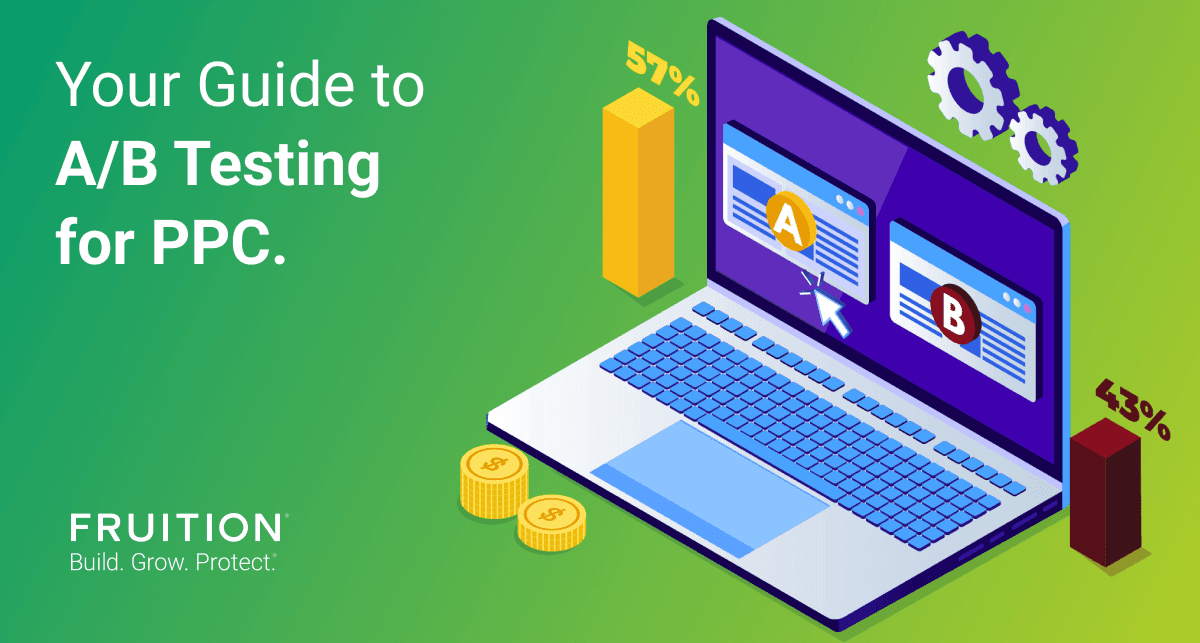Advanced A/B Testing for Effective PPC Campaigns | Fruition

Advanced A/B Testing for Effective PPC Campaigns | Fruition
Your Updated Guide to A/B Testing for PPC: 2023 Edition
As with all marketing strategies, optimizing your brand’s paid search or PPC (Pay Per Click) is crucial to boost conversions, increase traffic, or meet your other objectives. At Fruition, we believe that one of the most effective tools in your paid media arsenal is A/B testing, given that you adhere to the essential principles of this practice. Here are some A/B testing fundamentals to remember when you’re refining your paid campaigns.
The Significance of A/B Testing for Paid Search
Before delving into the best practices for A/B testing on PPC, let’s understand why it’s beneficial to A/B test in the first place. Here’s a brief overview of why A/B testing is likely a good idea for your paid campaigns.
[embed]https://www.youtube.com/watch?v=Hpkr24Tq_DA[/embed]
Essential Practices When A/B Testing for Paid Media
Keep Changes Simple and Remain Open-minded
When conducting A/B testing, you may be tempted to alter several factors in your B test, especially if you’re interested in examining multiple versions of your paid media placements. However, remember the scientific method from elementary school: A/B testing performs best when only one aspect of your campaign changes between the two versions of the paid media you plan to run.
For example, if you’re testing whether one Call-to-Action (CTA) is more effective and engaging than another for your brand’s audience, all other elements of the campaign (e.g., targeted audience, channel, general design or look of the ad) should remain the same. This will ensure that your data can accurately reflect which CTA performs better. If you want to test multiple aspects of the same campaign, consider running separate A/B tests over an extended period. Changes made all at once could lead to unclear results and leave you with data that won’t be helpful.
Duration Matters
Duration is often overlooked in A/B testing, especially for paid campaigns. Many companies terminate an A/B test prematurely either due to eagerness to see which option performs better, or because they underestimate the time required for data to accumulate. Since an A/B test requires sufficient traffic to yield results that depict your audience’s preference accurately, it is crucial to run your A/B test for at least 2-3 weeks. This duration is widely acknowledged as the optimal timeframe for A/B testing.
Stay Data-Driven
After the 2-3 week testing period, you’ll obtain results from your A/B test. The best approach is to let this data guide your subsequent actions, whether you intend to run a follow-up A/B test or build a single campaign based on the acquired information. The results might surprise you, but it’s always best to make decisions based on the data. If you need help interpreting complex data, consider consulting paid media professionals, like our team at Fruition, who can guide you in making informed decisions for your next paid campaign.
Impact of System Updates and Privacy Changes on Data
Remember that A/B testing and paid media do not exist in isolation. Widespread changes in the online world, such as alterations in Google algorithms or updates to Apple iOS operating systems, can influence how data appears in analytics software or applications. Keeping abreast of these changes allows you and your team to anticipate and adapt accordingly.
Privacy changes, like those concerning cookies pushed by iOS and Google platforms, can significantly impact how data is collected, analyzed, and reported online. Staying informed about these major shifts in internet functioning can give your team an edge when A/B testing.
Instances When A/B Testing for Paid Search May Not Be Beneficial
Despite its advantages, A/B testing for paid search may not always serve your brand effectively. Simply put, your brand’s data is only useful if you have enough traffic to measure. If your site doesn’t have a high level of traffic, your A/B tests might not yield statistically significant results.
Additionally, if your brand is in a niche market with a very specific audience, you might find that A/B testing doesn’t reveal much information, as your target audience’s preferences could be relatively uniform. In such cases, qualitative feedback and surveys could be more valuable.
This guide should prepare you for conducting effective A/B tests on paid media campaigns. However, if you need additional assistance or have more complex needs, feel free to reach out to our team at Fruition. We are always happy to help build your brand based on data-driven insights.
Conclusion
A/B testing is an indispensable tool for optimizing your PPC campaigns. It provides valuable insights into your audience’s preferences and behaviors, allowing you to make data-driven decisions and improve your campaign performance.
However, A/B testing is not a one-size-fits-all solution. It requires careful planning, execution, and analysis. You need to keep your changes simple, ensure your tests run for an adequate duration, and always stay focused on your data.
Moreover, you must stay abreast of the latest industry updates and changes, particularly in the areas of system updates and privacy. These factors can significantly impact your data and, consequently, your A/B testing results.
Ultimately, while A/B testing can be highly beneficial, it’s not always the best approach for every brand or situation. Therefore, it’s crucial to understand when and how to use it effectively.
Should you need any assistance in this regard, don’t hesitate to reach out to our team at Fruition. We are committed to helping you leverage data-driven insights to build and grow your brand.
References:
- “A/B testing,” Google Ads Help, 2023. [Online]. Available: https://support.google.com/optimize/answer/6211930?hl=en
- “Updates on Google’s Privacy Sandbox: What You Need to Know,” Fruition, 2023. [Online]. Available: https://fruition.net/blog/privacy-sandbox-updates/.
- “iOS14 & iOS15 Update: What You Need to Know,” Fruition, 2023. [Online]. Available: https://fruition.net/blog/ios14-ios15-update-what-you-need-to-know/.





